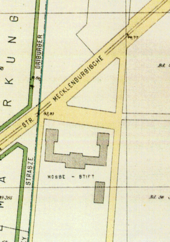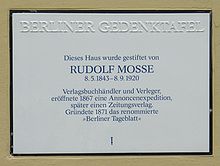Mosse pen
The Mosse-Stift is a building in the Berlin district of Wilmersdorf in the Charlottenburg-Wilmersdorf district , which was built from 1893 to 1895. It is named after its founders Emilie and Rudolf Mosse , who had an interdenominational orphanage built here.
history
At the end of the 19th century, the wealthy newspaper publisher Rudolf Mosse and his wife Emilie donated an interdenominational orphanage for 100 children. For this purpose, they acquired a five- acre (around 12,500 square meter) plot of land away from the existing development between the villages of Wilmersdorf and Schmargendorf . On the northern edge of the site, on Mecklenburgische Strasse, the old connecting road between the two villages, a palace-like building was erected from 1893 to 1895 , with a park being laid out on the remaining site to the south. The historicizing building was laid out as a neo-baroque three - wing complex with a domed central projection. Above a basement , the building has two full floors and a loft. The roof is covered with black slate . There are different statements about the architect; both Gustav Ebe and Alfred Sproemberg are named.
The facility was opened under the name Mossesche Educational Institute for Boys and Girls on April 1, 1895, for whose operation the couple founded the Emilie and Rudolf Mosse Foundation in 1908 . For the purpose of the foundation, the foundation charter stated: “The foundation aims to provide free care for needy children, preferably from the educated classes regardless of creed.” The aim of the Mosses was to help children from the impoverished middle class who received no help from public welfare could expect to enable qualified education and training. Georg Heinitz, Ernst Heinitz's father, was the founding director and long-time director of the Mosseschen Erziehungsanstalt . He was of the Jewish faith and before his appointment to the Mosse-Stift he was an educator at the Jacobsonschule , a secondary school in Seesen, for eight years . After Rudolf Mosse's death, his widow could no longer run the facility during the inflation and donated the building to the city of Berlin in 1922 on the condition that it continue to be used for child and youth welfare while retaining the name. Heinitz was taken over as director in the city service.
After its original use as an educational institution, it was converted into a home for apprentices and babies under the direction of the Wilmersdorf district in 1928-29. The name of the Jewish donors disappeared under the National Socialists and the house became the Knesebeck Children's Clinic in 1936 and, after the Second World War, the Wilmersdorf Municipal Children's Clinic . 1977-81 there was a further renovation for use as a rehabilitation center . As early as the 1980s, however, the house was used again as a home for apprentices and young people. Since the late 1990s, mainly children's and youth facilities have been located in the building again. These include the “InSideOut” children's and youth leisure center run by the Deutsche Schreberjugend , three day-care centers, two children's and youth residential groups , the state office and two local associations of the Association of Boy Scouts and - since 2014 - the Charlottenburg-Wilmersdorf environmental agency. In the former park there is a large children's playground and an adventure playground .
The building is now a listed building . At the entrance to the right of the central risalit there is a memorial plaque for Emilie and Rudolf Mosse from the time when the building served as a home for apprentices and young people. On May 9, 1989, a Berlin commemorative plaque for Rudolf Mosse was also placed on the transverse front of the west wing . After it was barely visible behind a growing conifer, it was moved to the east wing in May 2007.
supporting documents
- ↑ Entry in the Berlin State Monument List
- ^ A b Architects and Engineers Association in Berlin (ed.): Social buildings . Berlin and its buildings , part VII, volume B. Ernst & Sohn, Berlin 2003, pp. 25 and 324
- ↑ a b Speech by District Mayor Horst Dohm on the unveiling of the memorial plaque for Rudolf Mosse on May 9, 1989 at the Rudolf-Mosse-Stift
- ↑ Guide to the Papers of the Mosse Family, 1676-2001 Leo Baeck Institute, Center for Jewish History (English)
- ↑ Quoted after the speech of the district mayor Horst Dohm on the unveiling of the memorial plaque for Rudolf Mosse on 9 May 1989 at the Rudolf Mosse monastery
- ^ E. Philippson, Report on the Jacobson School , Jäger & Sohn, Goslar 1895, p. 11
- ^ Elisabeth Kraus, Die Familie Mosse , CH Beck, Munich 1999, p. 421
Web links
- Entry in the Berlin State Monument List
- Mosse pen in the encyclopedia of the Charlottenburg-Wilmersdorf district
- Mosse pen in the district lexicon of Edition Luisenstadt
- Children's and youth leisure center "Mosse"
Coordinates: 52 ° 28 ′ 28.5 ″ N , 13 ° 18 ′ 13.4 ″ E




